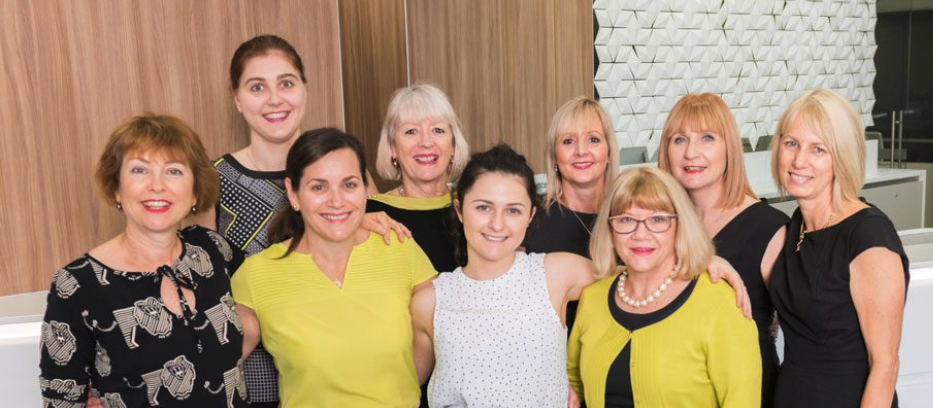This is a guest post from Karen Campbell, Practice Manager at Brisbane Clinical Neuroscience Centre. Karen recently spoke at the 2017 AAPM Conference on how her personal experiences have helped shape the clinic’s focus on patient-centric care.
Every day people ask me what it is like running a large neurosurgery practice and my answer is always the same.
It is a privilege.
Sure, managing neurosurgeons is like herding cats, and patients can be challenging. But how fortunate I am to work alongside talented surgeons who save people’s lives, and to be a part of a patient’s journey when they are at their most vulnerable.
I actually thought I was a pretty good manager. I had grown a practice from the days before risk management and privacy legislation, when patient charts and x-rays rattled around the boot of a second-hand Renault which spluttered between six hospitals and a cupboard in a mate’s dermatology practice. Timing and a little bit of luck saw the practice grow and life ticked along according to plan, in a blur of babies and BAS statements.
And then cancer happened. Some lumpy bits turned into a breast cancer diagnosis, which became metastatic with a spine tumour and the devastating discovery of a brain tumour. Life was pretty challenging for both myself and my entourage, but it was certainly an opportunity experience things from the other side of the sheets.
I’ve seen 12 specialists, had 14 operations including brain surgery, and lost count of the radiation, chemotherapy, immune therapy and trial drugs in my tsunami of treatments. I can tell you that I have had 59 scans and x-rays and 219 blood tests. I am quite the expert on the patient experience, and am giving myself a PhD on the topic! So what have I learned and what have I done about it?
Let’s talk about what patients don’t like
Patients don’t like waiting.
Not just waiting for their doctor to turn up (and let’s face it, we all hate paying for parking). Patients don’t like waiting for an appointment, for results, or for information about their clinical pathway.
Furthermore, there is nothing worse than walking out of a consultation clutching an x-ray form, referral to another specialist, a sense that you might need a second opinion, or travelling to yet another location for treatment.
Finally, patients don’t like getting lost. I don’t mean this literally.
Patients want to be treated as a person, not a diagnosis. They want their specific needs met. Patients want ACCESS, COHESION and CONNECTION, which coincidentally is EXACTLY what their referring doctors want.
In the midst of all my medical management, our practice accepted an opportunity to move to a larger space. This was a chance to flip things, a chance to establish a truly patient-centric practice, so what did we change?
Give patients better Access
At the BCNC we now have a rapid access policy for neurosurgical patients. An anxious patient, or concerned GP can phone a hotline and obtain an appointment within 24 hours. Doctors can phone the same line for an immediate connection to a neurosurgeon on-site to assist with clinical decisions.
Patients are savvy consumers who want convenience and medicine on their terms (and don’t forget we all hate paying for parking!). We have responded to this trend by taking the medicine to the people. We now have 10 outreach clinics in rural hubs like Gladstone, Rockhampton and Toowoomba and to support these clinics, I have cranked up our telehealth service. There is a growing demand for telemedicine and if you are designing a new fitout, I would highly recommend a soundproof telemedicine room. Our patients in rural and remote Queensland are a mouse click away, are often the most technologically savvy amongst our caseload, and linking the GP into the consultation provides valuable support. Interestingly, as our telehealth practice is becoming more extensive, we are seeing an increasing number of international patients.
Access starts at the front desk, and I resented being ignored by reception staff, clutching a telephone, with eyes glued to the computer screen. We have a phone system that can log out reception staff during clinics, and calls are managed by a phone hub in a rear admin area, protecting privacy and freeing the front desk team to do what they do best: enhance the patient experience.
Cohesion between practitioners
Seamless management can occur on several levels. Firstly, having a large group of surgeons means that patients have the benefit of a second, third or fourth opinion, if that is what they want. It is not unusual for two neurosurgeons to operate together on complex cases and individual interest or subspecialties optimise a clinical pathway as a patient can be matched to a doctor. An on-call roster with a shared database means continuity of care and patients are not left high and dry when their surgeons go on holidays.
Secondly, having a large number of aligned specialties on site, provides layers of care. Neurosurgery is mostly a collaborative discipline and complementary specialties in-house like ENT surgeons, neurologists, pain physicians and radiation oncologists means ease of appointment scheduling and comprehensive exchange of medical information. A one-stop shop, so to speak – and patients love it.
Thirdly, I have introduced a patient hub – a team of staff who provide a concierge experience for our patients.
They might sort accommodation, financial consent, a pre-admission assessment, radiology, anything really. No-one leaves the practice clutching a post-it note scrawled with instructions or a sense that they have forgotten something. Don’t tell the surgeons, but it is the patient hub team who get the most compliments!
Establish Connections with your patients
I had a brilliant breast care nurse taking care of me. She provided education, support, and was my advocate. How obvious to replicate this model in our business and now our two practice nurses enhance the patient-centric management.
They are the pre-operative point of contact, and provide valuable social-emotional support, nursing care and education. The nurses contact the patients regularly during the critical post-operative period, providing support, monitoring of wounds, pain management and recovery. They are essentially a human chain linking the patient journey through to the post-operative appointment with their surgeon.
Finally, do not underestimate the importance in training your staff to understand patient perspective. I was not a craniotomy, I was a mother of three, and I needed expert care to get me home to my family. My husband was not ‘difficult’, he was frightened. My dignity was important, and so was hope. We train our staff to understand that every patient has a back story and take away pain or anxiety and you are dealing with a completely different landscape.
In Summary
That is my take on a patient-centric practice.
In case you were wondering, my story has a happy ending. Great surgeons and cutting edge medicine has seen me outlive my prognosis by six years. I am one very lucky girl. I still have treatment and good and bad days. I am optimistic but know that life can change with one MRI. I am privileged and feel a responsibility to make a bit of a difference, which is why I am happy to share my thoughts about a better patient experience with you. I am proud to provide patient-centred care. Live well, bring joy to your workplace, and take good care of your patients.


